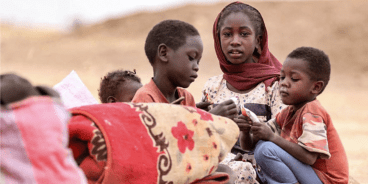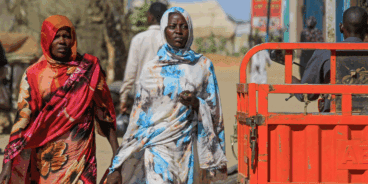

UN Human Rights Council Elections for 2026-2028 and the Responsibility to Protect
Today, 14 October 2025, the UN General Assembly elected Angola, Chile, Ecuador, Egypt, Estonia, India, Iraq, Italy, Mauritius, Pakistan, Slovenia, South Africa, the United Kingdom and Viet Nam to the Human Rights Council (HRC) for the 2026-2028 term. With their election, 22 of the 47 Council members during 2026 will be “Friends of the Responsibility to Protect” – having appointed a Focal Point for the Responsibility to Protect (R2P) and/or joined the Group of Friends of R2P in New York and Geneva.
Following these ‘clean slate’ elections, newly elected members of the HRC have an opportunity to strengthen the Council’s credibility and advance principled leadership in atrocity prevention. Membership in the HRC carries the obligation, set forth in UN General Assembly Resolution 60/251, to uphold the highest standards of human rights and to fully cooperate with the Council’s mechanisms and procedures. The new composition of the Council presents a fresh chance to reinforce its essential role in preventing atrocities and protecting populations at risk, particularly as several members have already demonstrated strong commitments to this goal. For a brief overview of how new HRC members engage with R2P and their status with international legal instruments, see the closing annex in the downloadable PDF version.
The HRC has an essential role in advancing R2P and supporting the prevention of mass atrocity crimes by monitoring human rights situations and using its mechanisms to provide early warning and respond to risks or occurrences of genocide, war crimes, crimes against humanity or ethnic cleansing. In July 2020 the HRC reaffirmed this responsibility in adopting a resolution on the “Fifteenth anniversary of the responsibility to protect populations from genocide, war crimes, ethnic cleansing and crimes against humanity, as enshrined in the World Summit Outcome of 2005.”
The HRC is equipped with a wide-ranging toolbox through its mechanisms and procedures that contribute directly to early warning, prevention, accountability and protection. This includes the Universal Periodic Review (UPR), Special Procedures, investigative mechanisms such as Commissions of Inquiry (CoIs), Fact-Finding Missions (FFMs) and others, treaty bodies and the monitoring, reporting and technical assistance provided by the Office of the High Commissioner for Human Rights (OHCHR).
Since systematic or widespread human rights violations serve as early warning signs of possible atrocities, Geneva-based mechanisms are often the first to sound the alarm about escalating risks. UN Special Procedures, with both thematic and country-specific mandates, consistently raise early warnings on human rights emergencies and possible atrocity situations. UN-mandated investigative mechanisms gather evidence of human rights violations and abuses and identify those responsible, while serving as early warning tools. Additionally, their detailed reports not only deepen our understanding of atrocity risk factors, but also support prevention strategies, deter potential perpetrators, promote accountability and recommend structural reforms to strengthen national resilience. International treaty bodies and the UPR hold states accountable to their human rights obligations by assessing performance and offering concrete recommendations for improvement. The UPR also fosters dialogue on strengthening national resilience and protecting fundamental human rights.
These tools and procedures embody R2P in practice. They play an important role in helping states uphold their primary responsibility to protect, enable the international community to provide support in preventing mass atrocities and mobilize timely and decisive responses when states are manifestly failing, or unwilling, to protect their populations. Since 2008 the HRC has referred to states’ responsibility to protect their populations in over 85 thematic and country resolutions. Since it became operational in 2006, the Council has established 40 investigative bodies to respond to situations where serious violations and abuses of human rights were being committed.
Nevertheless, more work needs to be done to turn early warning into timely preventive action. Too often, the Council’s potential is undermined by a lack of political will or inconsistency/lack of action based on objective criteria. Selectivity and double standards not only undermine international law but erode trust, particularly with affected communities. Despite HRC-mandated investigative mechanisms producing clear documentation of potential atrocity crimes, the atrocity prevention lens and assessment of risks have not been systematically included within mandates. Meaningful political follow-up on investigative findings is frequently lacking, with mechanisms sometimes terminated even while risks remain imminent – as seen in the decision to end the investigations into Ethiopia in 2023, for example. The divide between Geneva and New York also remains a barrier to cohesive action, preventing early warning generated by HRC mechanisms from shaping Security Council (UNSC) action.
For the HRC to truly champion R2P, its members must move beyond rhetoric to practical, consistent action. The tools are already at hand, what is required is the political will to use them, the resources to sustain them and the commitment to bridge institutional divides. R2P is a promise to act on behalf of people for whom mass atrocities are not abstract words, but real acts that pose an existential threat to them, their loved ones and communities. Upholding this commitment is one of the surest ways the HRC can fulfill its founding promise of protecting human rights and dignity for all.
In this regard, the Global Centre for the Responsibility to Protect encourages all newly elected and existing HRC members to utilize the broad array of tools to advance early warning, prevention, accountability and protection:
Integrating Early Warning and Atrocity Risk Assessments into Resolutions, Mandates and Processes
-
-
- Systematically integrate atrocity prevention language in all relevant thematic and country-specific resolutions, mandates and debates on cross-cutting human rights issues.
- Support the inclusion of gender- and age-specific indicators in monitoring, risk assessments and reporting to ensure more targeted, inclusive and effective preventive strategies.
- Mandate Special Procedures and investigative mechanisms to conduct country-specific atrocity risk assessments, including by utilizing the UN Framework of Analysis for Atrocity Crimes, and encourage collaboration with the UN Office on Genocide Prevention and the Responsibility to Protect (OSAPG), where relevant.
- Use the UPR process to detect early warning signs of potential mass atrocity crimes and raise relevant questions regarding the ratification and implementation of core human rights treaties, as well as risk factors related to systematic violations and abuses of human rights.
-
Political Mobilization, Principled Action and Follow-up
-
-
- Request the holding of Special Sessions or Urgent Debates when warning signs of atrocity crimes, or a deterioration of protracted crisis situations, emerge, including those arising between sessions.
- Use relevant country-specific or thematic interactive dialogues, including during the General Debate under Item 4, to raise concern of emerging or protracted atrocity crises.
- Co-sponsor and support resolutions addressing situations involving serious violations and atrocity risks, guided by the Irish Principles which lay out independent and objective considerations to guide decisions on whether and when the HRC should respond to a country-specific situation.
- States that sponsor resolutions, as well as those involved in their implementation, should convene side events or briefings to discuss how these resolutions have been implemented, assess their impact and share challenges, lessons learned and good practices.
- Lead on initiatives to establish monitoring, reporting or investigative mandates.
- Provide sufficient funding and political support to Special Procedures, CoIs and FFMs.
- Resources should be ensured for local service providers delivering medical and psychosocial support to witnesses.
- Special Procedures should receive sufficient resources to hold regular consultations with civil society organizations, national human rights institutions and other relevant stakeholders.
- Sustain mandates for investigative mechanisms until risks have clearly subsided, avoiding premature closures.
- Strengthen follow-up on recommendations from the UPR, treaty bodies and investigative mechanisms by ensuring that relevant reports, analyses and recommendations are systematically shared with key stakeholders. This includes officials in capitals, relevant embassies and other intra-governmental bodies responsible for bilateral political, economic and diplomatic engagement with the country concerned.
- Governments should also enhance the systematic use of this information, particularly detailed analysis identifying perpetrators, at-risk communities, specific violations and the financing of atrocities, to inform decisions related to bilateral sanctions, development and economic cooperation, trade agreements and peace or mediation efforts.
-
Accessibility and Engagement with Affected Communities
-
-
- Ensure that the HRC is a safe space for human rights defenders and victim and survivor community engagement, including by strongly condemning reprisals, harassment and intimidation by UN member states and other entities against persons, groups and organizations cooperating or seeking to cooperate with the Council and its mechanisms.
- Work closely with civil society organizations, the Secretariat of the UN Geneva Office and the Bureau of the HRC to counter reprisals.
- Give visibility to affected communities and civil society, including women, Indigenous Peoples and LGBTQIA+ human rights defenders, and take concrete measures to protect, preserve and strengthen their participation in all formal and informal discussions and procedures at the HRC.
- Establish funds and/or provide technical assistance to local and national civil society organizations to enable them to better engage with the HRC, including through the provision of information and follow-up on implementation.
- Ensure that the HRC is a safe space for human rights defenders and victim and survivor community engagement, including by strongly condemning reprisals, harassment and intimidation by UN member states and other entities against persons, groups and organizations cooperating or seeking to cooperate with the Council and its mechanisms.
-
Normative Commitment and Leadership
-
-
- Ratify or accede to key treaties relevant to atrocity prevention, including the Genocide and Rome Statute, as well as align national laws with international obligations.
- Join or align with the Geneva-based Group of Friends of R2P, or if a member, actively support and participate to consolidate cross-regional support around R2P and its effective implementation.
- Apply a consistent, principled approach to all atrocity situations, regardless of political alliances.
- Consult all available materials on HRC candidates’ human rights records and cooperation with the HRC and its mechanisms to inform voting. Even in closed slate elections, refrain from voting in favor of candidates that do not meet the membership criteria as stipulated in Resolution 60/251.
- Withhold votes – leave the box blank – for HRC candidates whose governments are responsible for mass atrocity crimes and/or refusing to cooperate with HRC mechanisms.
- Encourage other Council members to adhere to the membership obligations outlined in Resolution 60/251.
-
Bridging the Geneva–New York Gap
-
-
- Institutionalize regular reporting from HRC investigative mechanisms to the General Assembly and UNSC, as well as formalize information-sharing channels to contribute to a more timely and decisive response in New York and Geneva.
- Support the UN Secretary-General in transmitting to the UNSC relevant decisions and reports by the HRC.
- Encourage the UNSC to request regular briefings by OHCHR and other relevant HRC mechanisms and procedures.
- Promote greater dialogue between human rights and peace and security agendas to ensure holistic UN responses.
- Make better use of OSAPG, including by requesting briefings from the Special Advisers on emerging or protracted crisis situations, drawing upon the Office’s early warning analysis and recommendations for action and supporting the stronger integration of OSAPG into relevant HRC discussions.
-
Related Content


Recommendations for the 51st Session of the Universal Periodic Review
